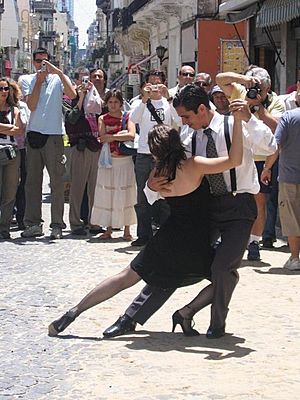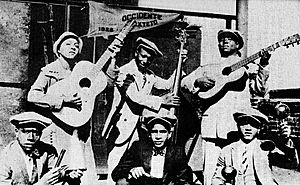Latin music facts for kids
Latin music is a type of popular music that comes from Latin America. This includes countries where Spanish is spoken, like many islands in the Caribbean. Most Latin music has songs sung in Spanish.
Latin music is part of what we call world music. This means it's a way to study popular and traditional music from all over the globe. Latin music has also had a big impact on music in other parts of the world, especially in North America.
When we talk about Latin music, a few things are really important to understand:
- Where it comes from: The country or even the specific region where the music started.
- European history: How European countries, especially Spain and Portugal, influenced the music because they used to rule these lands.
- Native cultures: The music and traditions of the native tribes who lived there first.
- African roots: The culture of the slaves who were brought from Africa.
- Music style: Different types of music, like church music, classical music, or popular music. In this article, we'll mostly focus on popular music.
For example, the music in Peru sounds different from the music in Brazil. This is because of their unique histories and cultures:
- Peru had fewer African slaves. Spain was its colonial ruler, and its Indian culture is still very strong. Most people in Peru are of Indian descent.
- Brazil had many African slaves, especially in the Bahia region. Today, many Brazilians have mixed ancestry. Portugal was its colonial ruler, and people there speak Portuguese, not Spanish. Brazil is also a much larger country than Peru.
Contents
How Europe Influenced Latin Music
Europe, especially Spain, brought many important things to Latin music:
- Musical notes: Musical notation allows musicians to write down music. This means anyone can learn to play a song, and composers can earn money from their work. It also helps us keep a record of old songs that aren't played anymore.
- European instruments: In almost every South American country and most Caribbean islands, the Spanish guitar is the most common instrument. There are also guitar variations like the Cuban tres and the Puerto Rican quattro. Other important instruments include the cornet (which later became the trumpet), the piano, the double bass, and the violin.
- Music schools: Formal teaching for composers, musicians, and singers started with the first cathedral in Cuba. This systematic way of teaching helps musicians play at a similar level, so bands can easily replace a musician if needed.
How Africa Influenced Latin Music
The influence of Africa mainly comes from the Yoruba, Dahomey, and Kongo peoples. How much Africa influenced a Latin country's music depends on how many slaves were brought there. Slaves were freed at different times, mostly in the mid to late 1800s. In Latin music, Africa's influence can be seen in:
- Percussion: Most types of percussion, especially drums, come from Africa. In Cuba, there were originally about 100 different types of drums! Today, only three are commonly used: the conga drums, the bongos, and the timbales. Congas and bongos are African. Other African percussion instruments include the clavés and shekeres. African influence also means percussion is very important in Afro-Latin music. It's common for a group of 10 or 12 musicians to have half of them playing percussion. Even string instruments are often plucked instead of bowed.
- Call and response: This is a common way of singing and playing music. One person or group sings a "call," and another responds. A famous example is in the movie Casablanca with the song Knock On Wood:
- CALL: Who's got trouble?
- RESPONSE: We've got trouble!
- CALL: How much trouble?
- RESPONSE: Too much trouble!
- African religions: Just as the Spanish brought the Catholic church, slaves brought their African religions. Today, these religions have different names. The word santería means a mix of Catholic saints and African spirits. For example, the African spirit Babalú is like the Catholic saint San Lazaro. The Yoruba religion in Cuba is called regla de ocha, and the Brazilian version is conbomblé. These ancient religions were central to life for the slaves. They brought their beliefs, dances, music, instruments, and ceremonies with them. Where their masters allowed it, they recreated their culture, and it has influenced popular music in Afro-Latin countries ever since.
How Native Peoples Influenced Latin Music
West of the Andes mountains, the music clearly shows the influence of the native Indian peoples. The panpipes and flutes of Peru have a unique sound, as do their most popular rhythms. In Ecuador, you'll find different kinds of flutes. However, most of Ecuador's music is influenced by the European waltz (like the pasillo) and Afro-Latin styles from the Caribbean. Chile has the cueca, which became popular in 1824 and was called the "most popular air of Chile."
Even with these examples, the influence of native Indian peoples on Latin music is much less noticeable than the influence of European and African music. Many folk rhythms from native cultures still exist, but they usually haven't spread much beyond their local areas. In contrast, Spanish and African influences are found almost everywhere. Even in Argentina, the famous tango uses a rhythm called the cinquillo. This is a syncopated rhythm, similar to the Cuban habanera. Syncopation and polyrhythms are clear signs of African influence. Argentina does have some folk tunes and rhythms of Indian origin, but the tango is much more dominant.
Latin Music in the U.S.A. After 1970
Lydia Mendoza (1916–2007), a singer of Mexican descent, was the first American-born Hispanic to record a song in Spanish in 1928. It was rare for Hispanic artists to record music in the early 1900s. By the 1960s, Tejano music (from the Southern United States and Mexico), Spanish folk (from Spain), salsa (from Puerto Rico), cumbia (from South America), and bachata (from the Dominican Republic) were the most popular types of Latin music.
In the 1970s, bolero became a popular music genre in Puerto Rico. Puerto Rican singer Hector Lavoe was one of its most important musicians. In the United States, speaking Spanish was not always accepted, and many Hispanics faced discrimination for it. Because of this, many children and young adults preferred English music like rock and roll and tried not to speak Spanish outside their homes.
In the 1980s, Latin music started to become more popular. The American music magazine Billboard added several Latin music categories. These included Top Latin Albums, Regional Mexican Albums, Tropical Albums, and the Latin Pop Albums chart. This made younger generations more interested in recording Latin music. However, in the late 1980s, freestyle music became the most popular Latin music genre. Freestyle music was rarely recorded in Spanish because speaking Spanish was still not very popular at the time.
In the 1990s, artists like Selena, Gloria Estefan, Luis Miguel, and Thalía became very famous. They helped make Latin music popular for young people. Selena became the most popular Latin artist in the United States in 1995. She was murdered at age 23. She was the first and only Latin artist to have an album with mostly Spanish music reach number one on the Billboard 200 chart. When she died, her album Dreaming of You (1995) sold 3 million copies in its first year. Enrique Iglesias, Shakira, Marc Anthony, Ricky Martin, and Jennifer Lopez also became popular in the mid and late 1990s.
In the 2000s, Latin music sales started to decrease. Tejano music became less popular, even though Selena, known as the "Queen of Tejano music," was named the "Top Latin Artist of the Decade" by Billboard in 1999. Shakira, Ricky Martin, and Jennifer Lopez continued to be very popular, with number one songs and albums on the Billboard 200. Marc Anthony, Aventura, Don Omar, and Enrique Iglesias remained popular in the Latin music scene.
In the 2010s, Prince Royce, Pitbull, Romeo Santos, and Wisin & Yandel became famous. Jennifer Lopez, Ricky Martin, and Shakira started to crossover into English music, while still releasing some Spanish songs. In the 2010s, bachata music became very popular thanks to Prince Royce and Romeo Santos. Meanwhile, reggaeton continued to be a dominant style on Latin music radios since the mid-2000s. As of 2012, Selena is still the best-selling Latin artist, with 60 million copies sold worldwide. Jennifer Lopez is second, with 55 million copies sold worldwide.
Images for kids
-
Spanish singer Julio Iglesias was recognized by the Guinness World Records in 2013 as the best-selling male Latin artist of all time.
See also
 In Spanish: Música latina para niños
In Spanish: Música latina para niños




